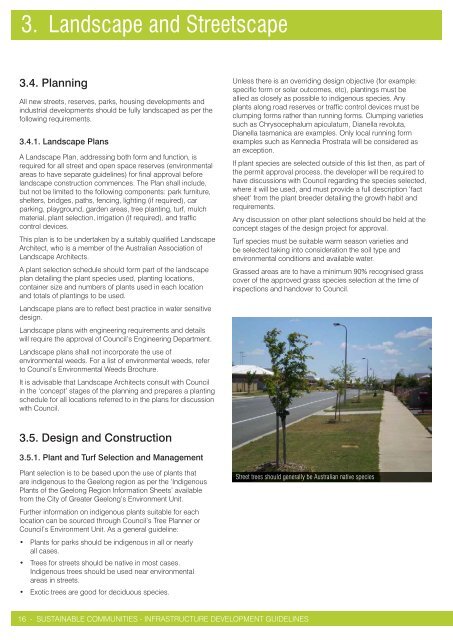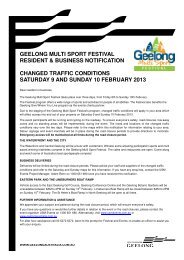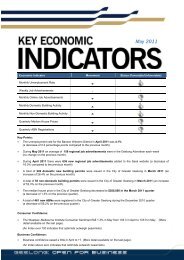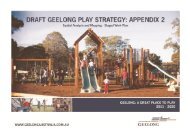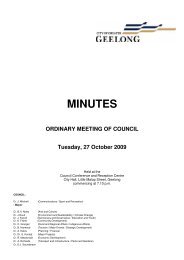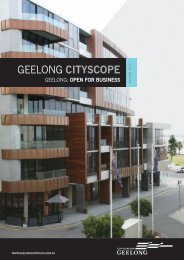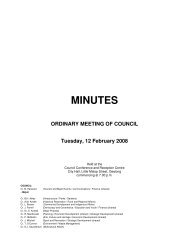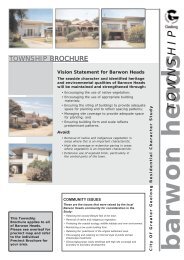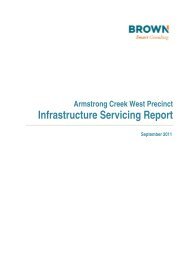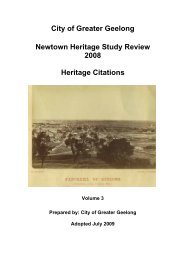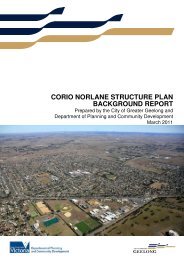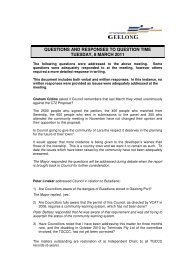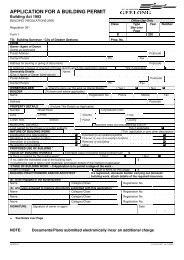3. Landscape and Streetscape - City of Greater Geelong
3. Landscape and Streetscape - City of Greater Geelong
3. Landscape and Streetscape - City of Greater Geelong
You also want an ePaper? Increase the reach of your titles
YUMPU automatically turns print PDFs into web optimized ePapers that Google loves.
<strong>3.</strong> <strong>L<strong>and</strong>scape</strong> <strong>and</strong> <strong>Streetscape</strong><br />
<strong>3.</strong>4. Planning<br />
All new streets, reserves, parks, housing developments <strong>and</strong><br />
industrial developments should be fully l<strong>and</strong>scaped as per the<br />
following requirements.<br />
<strong>3.</strong>4.1. <strong>L<strong>and</strong>scape</strong> Plans<br />
A <strong>L<strong>and</strong>scape</strong> Plan, addressing both form <strong>and</strong> function, is<br />
required for all street <strong>and</strong> open space reserves (environmental<br />
areas to have separate guidelines) for final approval before<br />
l<strong>and</strong>scape construction commences. The Plan shall include,<br />
but not be limited to the following components: park furniture,<br />
shelters, bridges, paths, fencing, lighting (if required), car<br />
parking, playground, garden areas, tree planting, turf, mulch<br />
material, plant selection, irrigation (if required), <strong>and</strong> traffic<br />
control devices.<br />
This plan is to be undertaken by a suitably qualified <strong>L<strong>and</strong>scape</strong><br />
Architect, who is a member <strong>of</strong> the Australian Association <strong>of</strong><br />
<strong>L<strong>and</strong>scape</strong> Architects.<br />
A plant selection schedule should form part <strong>of</strong> the l<strong>and</strong>scape<br />
plan detailing the plant species used, planting locations,<br />
container size <strong>and</strong> numbers <strong>of</strong> plants used in each location<br />
<strong>and</strong> totals <strong>of</strong> plantings to be used.<br />
<strong>L<strong>and</strong>scape</strong> plans are to reflect best practice in water sensitive<br />
design.<br />
<strong>L<strong>and</strong>scape</strong> plans with engineering requirements <strong>and</strong> details<br />
will require the approval <strong>of</strong> Council’s Engineering Department.<br />
<strong>L<strong>and</strong>scape</strong> plans shall not incorporate the use <strong>of</strong><br />
environmental weeds. For a list <strong>of</strong> environmental weeds, refer<br />
to Council’s Environmental Weeds Brochure.<br />
It is advisable that <strong>L<strong>and</strong>scape</strong> Architects consult with Council<br />
in the ‘concept’ stages <strong>of</strong> the planning <strong>and</strong> prepares a planting<br />
schedule for all locations referred to in the plans for discussion<br />
with Council.<br />
Unless there is an overriding design objective (for example:<br />
specific form or solar outcomes, etc), plantings must be<br />
allied as closely as possible to indigenous species. Any<br />
plants along road reserves or traffic control devices must be<br />
clumping forms rather than running forms. Clumping varieties<br />
such as Chrysocephalum apiculatum, Dianella revoluta,<br />
Dianella tasmanica are examples. Only local running form<br />
examples such as Kennedia Prostrata will be considered as<br />
an exception.<br />
If plant species are selected outside <strong>of</strong> this list then, as part <strong>of</strong><br />
the permit approval process, the developer will be required to<br />
have discussions with Council regarding the species selected,<br />
where it will be used, <strong>and</strong> must provide a full description ‘fact<br />
sheet’ from the plant breeder detailing the growth habit <strong>and</strong><br />
requirements.<br />
Any discussion on other plant selections should be held at the<br />
concept stages <strong>of</strong> the design project for approval.<br />
Turf species must be suitable warm season varieties <strong>and</strong><br />
be selected taking into consideration the soil type <strong>and</strong><br />
environmental conditions <strong>and</strong> available water.<br />
Grassed areas are to have a minimum 90% recognised grass<br />
cover <strong>of</strong> the approved grass species selection at the time <strong>of</strong><br />
inspections <strong>and</strong> h<strong>and</strong>over to Council.<br />
<strong>3.</strong>5. Design <strong>and</strong> Construction<br />
<strong>3.</strong>5.1. Plant <strong>and</strong> Turf Selection <strong>and</strong> Management<br />
Plant selection is to be based upon the use <strong>of</strong> plants that<br />
are indigenous to the <strong>Geelong</strong> region as per the ‘Indigenous<br />
Plants <strong>of</strong> the <strong>Geelong</strong> Region Information Sheets’ available<br />
from the <strong>City</strong> <strong>of</strong> <strong>Greater</strong> <strong>Geelong</strong>’s Environment Unit.<br />
Further information on indigenous plants suitable for each<br />
location can be sourced through Council’s Tree Planner or<br />
Council’s Environment Unit. As a general guideline:<br />
• Plants for parks should be indigenous in all or nearly<br />
all cases.<br />
• Trees for streets should be native in most cases.<br />
Indigenous trees should be used near environmental<br />
areas in streets.<br />
• Exotic trees are good for deciduous species.<br />
Street trees should generally be Australian native species<br />
16 - SUSTAINABLE COMMUNITIES - INFRASTRUCTURE DEVELOPMENT GUIDELINES


